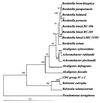Application of 16S rRNA gene sequencing to identify Bordetella hinzii as the causative agent of fatal septicemia
- PMID: 10655386
- PMCID: PMC86205
- DOI: 10.1128/JCM.38.2.789-794.2000
Application of 16S rRNA gene sequencing to identify Bordetella hinzii as the causative agent of fatal septicemia
Abstract
We report on the first case of fatal septicemia caused by Bordetella hinzii. The causative organism exhibited a biochemical profile identical to that of Bordetella avium with three commercial identification systems (API 20E, API 20 NE, and Vitek GNI+ card). However, its cellular fatty acid profile was not typical for either B. avium or previously reported strains of B. hinzii. Presumptive identification of the patient's isolate was accomplished by traditional biochemical testing, and definitive identification was achieved by 16S rRNA gene sequence analysis. Phenotypic features useful in distinguishing B. hinzii from B. avium were production of alkali from malonate and resistance to several antimicrobial agents.
Figures

References
-
- Altschul S F, Gish W, Miller W, Myers E W, Lipman D J. Basic local alignment search tool. J Mol Biol. 1990;215:403–410. - PubMed
-
- Felsenstein J. Confidence limits on phylogenies: an approach using the bootstrap. Evolution. 1985;39:783–791. - PubMed
-
- Fox G E, Wisotzkey J D, Jurtshuk P. How close is close: 16S rRNA sequence identity may not be sufficient to guarantee species identity. Int J Syst Bacteriol. 1992;42:166–170. - PubMed
Publication types
MeSH terms
Substances
Associated data
- Actions
- Actions
LinkOut - more resources
Full Text Sources
Molecular Biology Databases

